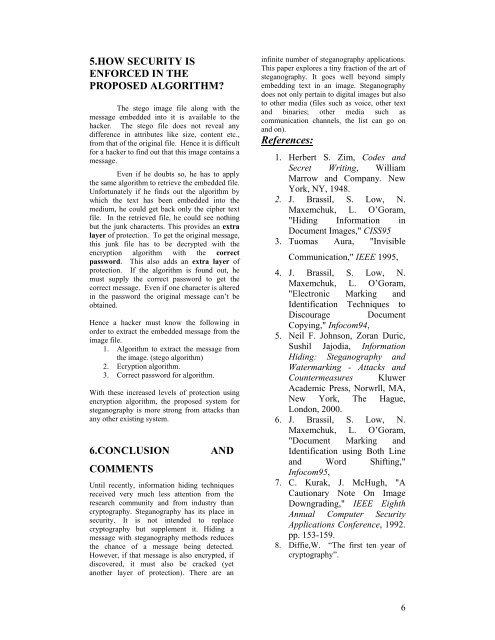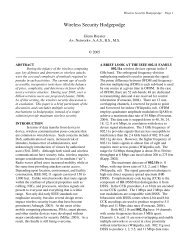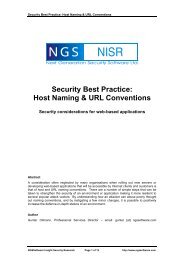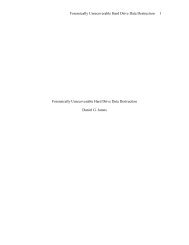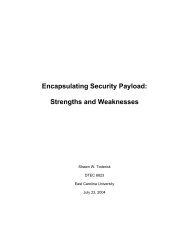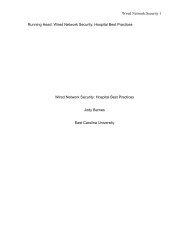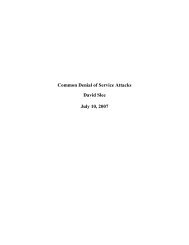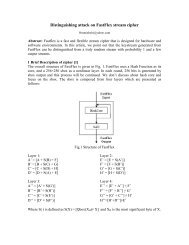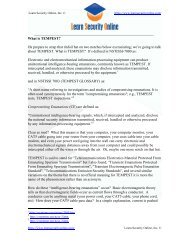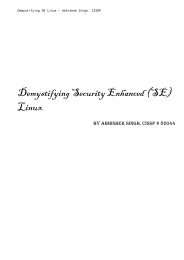Data security through obscurity - Rootsecure.net
Data security through obscurity - Rootsecure.net
Data security through obscurity - Rootsecure.net
Create successful ePaper yourself
Turn your PDF publications into a flip-book with our unique Google optimized e-Paper software.
5.HOW SECURITY IS<br />
ENFORCED IN THE<br />
PROPOSED ALGORITHM?<br />
The stego image file along with the<br />
message embedded into it is available to the<br />
hacker. The stego file does not reveal any<br />
difference in attributes like size, content etc.,<br />
from that of the original file. Hence it is difficult<br />
for a hacker to find out that this image contains a<br />
message.<br />
Even if he doubts so, he has to apply<br />
the same algorithm to retrieve the embedded file.<br />
Unfortunately if he finds out the algorithm by<br />
which the text has been embedded into the<br />
medium, he could get back only the cipher text<br />
file. In the retrieved file, he could see nothing<br />
but the junk characterts. This provides an extra<br />
layer of protection. To get the original message,<br />
this junk file has to be decrypted with the<br />
encryption algorithm with the correct<br />
password. This also adds an extra layer of<br />
protection. If the algorithm is found out, he<br />
must supply the correct password to get the<br />
correct message. Even if one character is altered<br />
in the password the original message can’t be<br />
obtained.<br />
Hence a hacker must know the following in<br />
order to extract the embedded message from the<br />
image file.<br />
1. Algorithm to extract the message from<br />
the image. (stego algorithm)<br />
2. Ecryption algorithm.<br />
3. Correct password for algorithm.<br />
With these increased levels of protection using<br />
encryption algorithm, the proposed system for<br />
steganography is more strong from attacks than<br />
any other existing system.<br />
6.CONCLUSION<br />
COMMENTS<br />
AND<br />
Until recently, information hiding techniques<br />
received very much less attention from the<br />
research community and from industry than<br />
cryptography. Steganography has its place in<br />
<strong>security</strong>. It is not intended to replace<br />
cryptography but supplement it. Hiding a<br />
message with steganography methods reduces<br />
the chance of a message being detected.<br />
However, if that message is also encrypted, if<br />
discovered, it must also be cracked (yet<br />
another layer of protection). There are an<br />
infinite number of steganography applications.<br />
This paper explores a tiny fraction of the art of<br />
steganography. It goes well beyond simply<br />
embedding text in an image. Steganography<br />
does not only pertain to digital images but also<br />
to other media (files such as voice, other text<br />
and binaries; other media such as<br />
communication channels, the list can go on<br />
and on).<br />
References:<br />
1. Herbert S. Zim, Codes and<br />
Secret Writing, William<br />
Marrow and Company. New<br />
York, NY, 1948.<br />
2. J. Brassil, S. Low, N.<br />
Maxemchuk, L. O’Goram,<br />
"Hiding Information in<br />
Document Images," CISS95<br />
3. Tuomas Aura, "Invisible<br />
Communication," IEEE 1995,<br />
4. J. Brassil, S. Low, N.<br />
Maxemchuk, L. O’Goram,<br />
"Electronic Marking and<br />
Identification Techniques to<br />
Discourage Document<br />
Copying," Infocom94,<br />
5. Neil F. Johnson, Zoran Duric,<br />
Sushil Jajodia, Information<br />
Hiding: Steganography and<br />
Watermarking - Attacks and<br />
Countermeasures Kluwer<br />
Academic Press, Norwrll, MA,<br />
New York, The Hague,<br />
London, 2000.<br />
6. J. Brassil, S. Low, N.<br />
Maxemchuk, L. O’Goram,<br />
"Document Marking and<br />
Identification using Both Line<br />
and Word Shifting,"<br />
Infocom95,<br />
7. C. Kurak, J. McHugh, "A<br />
Cautionary Note On Image<br />
Downgrading," IEEE Eighth<br />
Annual Computer Security<br />
Applications Conference, 1992.<br />
pp. 153-159.<br />
8. Diffie,W. “The first ten year of<br />
cryptography”.<br />
6


